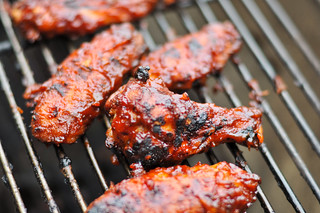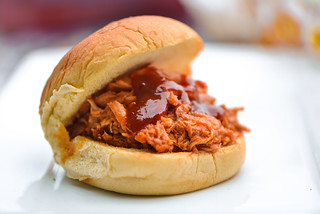Spicy Mustard Barbecue Chicken
Being nearly 350 sauce reviews deep has given me a good perspective on my personal taste preferences, and it also means I've grilled at least that many pieces of barbecue chicken. I've made so much barbecue chicken that the process is second nature to me now. That's probably why barbecue chicken no longer pops up as a recipe idea anymore, and the last time I posted a new one for this backyard stable was back in 2010. My process hasn't changed since then, so there isn't anything new for me to say in that realm, but there is a whole world of flavoring combinations that I could be exploring,, so I'm picking this topic back up again with this spicy mustard-tomato barbecue chicken.
A number of my favorite pieces of chicken that have come out of all that testing have been those that use a sauce that's a combo of mustard and tomato. This duo provides the sweet tomato underpinnings of barbecue sauce, but a dialed up mustard keeps the sugars in check and adds an additional acidity and bite that pairs especially well with chicken. So to start out this recipe, I first needed to develop a sauce along those lines, and I've already documented all the thought and process that went into crafting the recipe.
I made the sauce first before figuring out the correct pairing rub, which was a good call because the sauce turned out spicier than I had originally imagined. This left me devising a rub that leaned into sugar more to strike a good contrast with a spicy sauce. So the base of this rub was combo of light brown and turbinado sugars with a fairly standard mixture of spices added in to that to deliver a hallmark barbecue taste.
I usually will select thighs and legs for barbecue chicken because my process requires longer cooking times to be at its best, and those two cuts are very forgiving when cooked at high heat. I started the prep here by trimming away any excess fat and skin from the chicken pieces and then giving each a good sprinkle of rub all over.
Getting the best barbecue chicken is a multi-step process, with each step being pretty crucial in building up an immense barbecue flavor. To start, I cooked the chicken over indirect high heat. This first roast gives time for the meat to cook, the exterior to lose moisture, and in return, for the rub to develop color.
At this point the meat is still likely a good ten to fifteen minutes from being done, and this is when I apply at least two brushings of sauce, letting the chicken sit covered between each one to give the sauce time to set. It took a little more than five minutes between brushings for this to happen, and by the time the process was complete, the chicken had a decent layer of well adhered sauce.
The final step is to move the chicken over direct heat to caramelize the sauce a bit. By now the chicken had been cooking for about 30 minutes, so the fire had died down from blazing hot to outputting a more gentle medium-ish heat. This helped the sauce brown and darken in spots without burning. Once the direct heat portion is done, I sometimes add one final brushing if it looks like too much sauce burned off, and on this particular day, the chicken did benefit from that extra sauce layer,
When I think of what I want out of barbecue chicken, this specimen had it all. The first bite had a light tomato sweetness that was balanced out with some heat, tang, and bite from the mustard, vinegar, and peppers. While the exterior flavor was intense, the juices of the chicken mixed in and diluted it in a manner that made taking another subsequent bite not only welcomed, but highly desirable. The sauce also picked up caramelization here and there, and those darkened bits were the best parts with concentrated pockets of flavor that made the chicken taste distinctly grilled. Now the barbecue chicken recipe I posted nearly fifteen years ago was equally as good, but this sauce is something special, so it feels good to have taken this backyard staple out for another spin.










